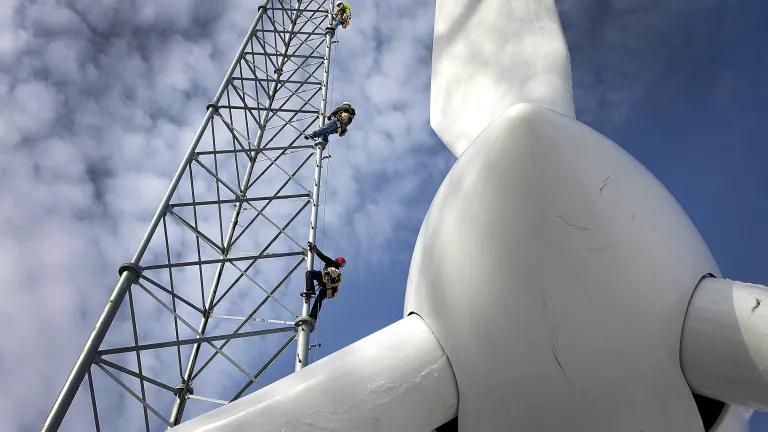Electric Grid Resilience and FERC: What Happens Next?

On March 9, the nation’s regional grid operators are poised to tell their regulator—the Federal Energy Regulatory Commission (FERC)—what they are doing about grid “resilience” and what, if anything, FERC should do about it. Here’s a preview of what the grid operators are likely to say, and how FERC should respond. Whatever they do tell FERC, it is critical to keep in mind that there is no evidence of a resilience crisis, let alone one requiring a new FERC mandate. That’s in part because grid operators already incorporate resilience into many of their reliability-focused responsibilities. Nonetheless, as it did in last month’s energy storage rule, FERC can continue to take resilience-friendly actions necessary to integrate new technology and changing consumer preferences into grid planning, markets, and operations.
Background on the grid operators’ resilience plans
The nation’s six regional grid operators, which cover nearly 70 percent of the country’s power demand, are submitting specific information to FERC about how they address resilience. Their filings come this week because FERC required them to do so when it rejected the Department of Energy’s (DOE) scheme to bail out financially troubled coal and nuclear power plants. In early January 2018, FERC rightly rejected DOE’s proposal for several reasons, including that there was a woeful lack of evidence to support the claim that coal and nuclear plants are necessary to support resilience, that DOE failed to define resilience or differentiate from existing efforts to ensure reliability, and that the proposed bailout arbitrarily supported coal and nuclear plants over other technologies.
It’s worth remembering that grid operators and others began thinking about resilience long before it was raised by the DOE’s bailout proposal. The National Academies of Sciences, Engineering, and Medicine, for example, released a comprehensive report on grid resilience in 2017, detailing resilience-related actions and recommending a series of steps that grid operators should take to enhance it. (Not surprisingly, none of their suggestions included propping up coal or nuclear plants.) But because DOE’s proposal was based on a flawed understanding of resilience, FERC’s rejection of it provided a natural forum to request more—and hopefully better—information on the topic from grid operators. After the grid operators respond by March 9, the public and the power industry will have the opportunity to comment on the grid operators’ responses by April 9. FERC will then decide what, if anything, it will do next.
Defining resilience
“Resilience” typically refers to providing reliable power service during normal and challenging conditions, recovering quickly from extreme weather and other damaging events, and minimizing harmful impacts to public health and safety. Reliability and resilience overlap significantly, especially when considering the scope of FERC’s legal authority over resilience. FERC and the grid operators focus primarily on preserving grid reliability, which means maintaining a stable power supply during normal and abnormal conditions, in time scales ranging from seconds to years.
Grid operators and transmission-owning utilities are subject to a host of enforceable reliability standards that make the system more resilient. Some, like “vegetation management,” might seem mundane, yet downed trees are a major source of blackouts, so keeping transmission lines clear of trees and other vegetation is an ongoing priority. FERC and others also are expanding standards to protect against physical and cyber-attacks. Many other grid planning, market, and operations rules also support both reliability and resilience.
All of this is to say that reliability and resilience closely overlap for FERC’s purposes, and that resilience is already embedded within grid operators’ core responsibilities. Yet the word has taken on a near-magical meaning for those, like owners of financially failing power plants, who see it as a password to life support for their plants.
What will the grid operators say?
Most grid operators are unlikely to ask FERC to take drastic action and create new markets or payments in the name of resilience. That’s because resilience is already embedded in the fabric of their markets, planning, and operations. The last thing most of them want is a top-down FERC mandate that could disrupt these existing frameworks. Some may urge FERC to nudge them forward on existing initiatives, but few are likely to ask FERC to issue a broad resilience order or mandate.
On the other hand, two grid operators may link resilience to potential changes to their markets. PJM, which already has a resilience roadmap in place, likely will ask FERC for a directive to pursue a broad range of activities in the near future, justified based on a purported need for enhanced resilience. A glaring flaw with PJM’s plan is that it hasn’t yet demonstrated that costly actions, which could enrich the owners of failing power plants, are necessary. PJM’s heavy-handed and accelerated approach also would severely limit stakeholder discussions at a time when few agree on how to measure resilience separately from reliability.
The grid operator for New England (ISO New England), has raised concerns about New England’s growing reliance on natural gas, and recently floated the idea of paying many millions of dollars to oil or nuclear generators not to retire, along with previous calls to build more gas pipelines in the region. NRDC and many other stakeholders, including environmental groups, consumer advocates, and generators, question the basis for the grid operator’s conclusions, in part because the grid operator is undervaluing contributions from clean energy resources. However, we do agree with ISO New England’s view that FERC should not prematurely intervene and should instead allow discussions between the grid operator and its stakeholders to continue.
Our recommendations
Many environmental and consumer groups, and others, have already weighed in with MISO, PJM, and ISO New England as they consider how to respond to FERC’s questions. We have stressed that grid operators carry a heavy burden to justify any new compensation scheme that would benefit power plant owners while making customers pay more. As FERC said in its January 2018 order rejecting the Administration’s coal/nuclear bailout proposal, “there is no evidence in other Commission proceedings” suggesting that grid operator rules violate federal law because they don’t adequately account for resilience.
On the other hand, FERC can continue to take actions under its existing authorities that benefit both consumers and resilience. As we know from the recent storms and recent outage data, most grid disruptions and blackouts occur from downed neighborhood power lines. FERC doesn’t regulate these lines, which are under state jurisdiction. But, FERC-regulated grid operators can help protect neighborhoods, such as by swiftly implementing FERC’s recent rule on integrating energy storage into their power markets, easing market access for other consumer-controlled energy resources connected to neighborhood lines, and ramping up real-time and long-term coordination with local power systems.
Yes, some areas of the grid do face reliability and resilience issues, just as they have in the past. Cyber-attacks are a growing high-impact threat to the power grid. More frequent and severe storms as a result of climate change are also increasingly challenging grid resilience and reliability. Witness Puerto Rico as the island recovers from Hurricane Maria, and in the Northeast, Hurricane Sandy and the recent “bomb cyclones.” But many of these challenges, especially those within the power of grid operators and FERC to fix, are local or regional and need surgical, customer-focused solutions.
To the extent FERC or grid operators do identify any new resilience challenges, they will need to carefully define these concerns, including the magnitude and likelihood of the threat and the range of potential solutions. Any future actions FERC or grid operators take on resilience should be evidence-based, fuel-neutral, and based on objective resilience criteria subject to stakeholder scrutiny. That’s in line with the National Academies’ grid resilience report, which stresses the need for evidence-based measures of resilience.
The bottom line is that any solutions must improve grid resilience and reliability, and not simply force customers to pay for the failing technologies of the past.
This blog provides general information, not legal advice. If you need legal help, please consult a lawyer in your state.




